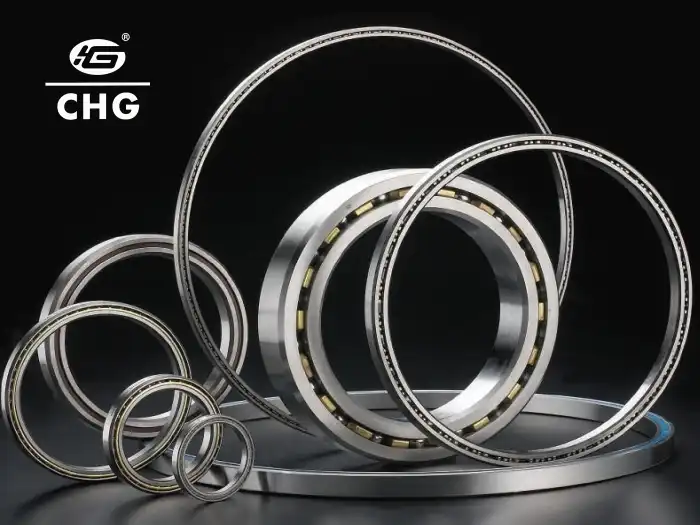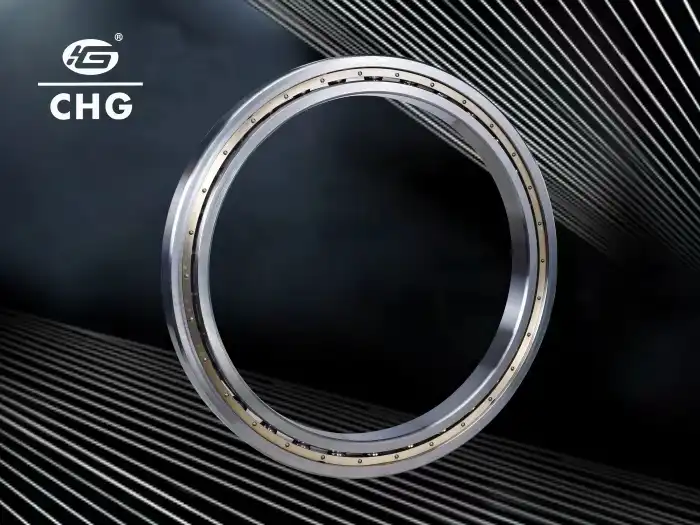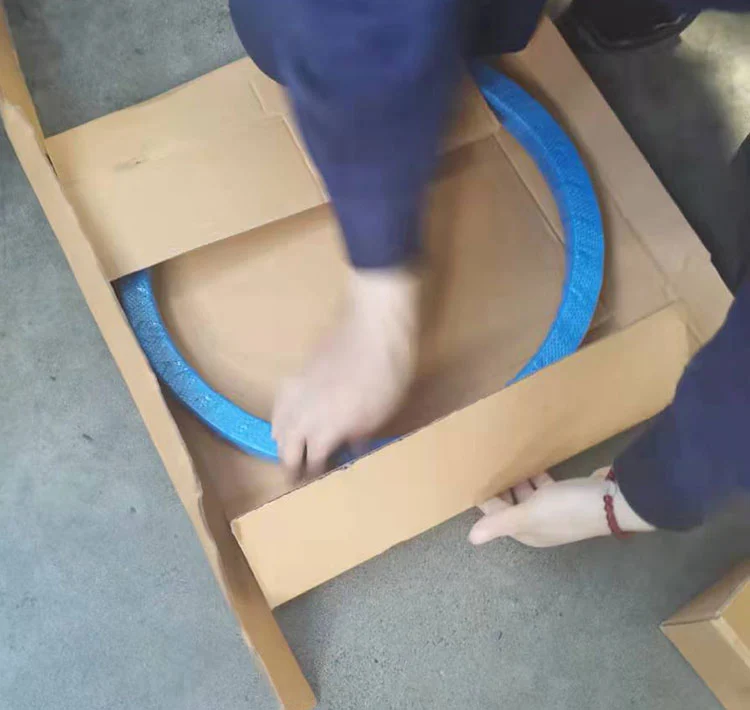Type C Thin Section Bearing vs A-Type and X-Type: Load Comparison
In the world of precision engineering, thin section bearings play a crucial role in various applications where space is at a premium, but performance cannot be compromised. Among these, the Type C Thin Section Bearing stands out as a versatile and efficient option, especially when compared to its counterparts, the A-Type and X-Type bearings. This comprehensive analysis delves into the load comparison between these bearing types, focusing on the unique characteristics of the Type C Thin Section Bearing. As we explore the intricacies of these bearings, we'll uncover how the Type C variant offers superior load-bearing capabilities in both radial and axial directions, making it an ideal choice for applications ranging from aerospace and medical equipment to robotics and industrial machinery. Understanding the nuances of these bearings is essential for engineers and designers looking to optimize their systems for maximum efficiency and longevity.
What are the key advantages of Type C Thin Section Bearings over A-Type and X-Type?
Space Efficiency and Design Flexibility
Type C Thin Section Bearings offer unparalleled space efficiency and design flexibility compared to A-Type and X-Type bearings. They are able to support more weight in smaller machinery designs thanks to their narrow cross-section. This quality is especially useful in components for aircraft or medical equipment when storage space is limited. Engineers are able to make lighter and more efficient designs using the Type C arrangement, which boosts system performance in the end. Also, designers have more leeway to solve problems and come up with new ideas since Type C Thin Section Bearings are so adaptable and easy to incorporate into different assemblies.
Enhanced Load Distribution Capabilities
One of the standout features of Type C Thin Section Bearings is their superior load distribution capabilities. Unlike A-Type and X-Type bearings, which may have limitations in handling combined loads, Type C bearings excel in managing both radial and axial loads simultaneously. The special design of the bearing uses a greater number of balls with smaller diameters to accomplish this balanced load distribution. Therefore, applications requiring great accuracy and stability under fluctuating load circumstances are excellent for Type C Thin Section Bearings since they can sustain larger loads relative to their size. With this increased load-bearing capability, operating life in harsh situations is prolonged and dependability is improved.
Reduced Friction and Improved Efficiency
Sort C Lean Area Orientation offer critical preferences in terms of decreased contact and progressed generally productivity compared to A-Type and X-Type choices. The plan of Sort C orientation, highlighting a bigger number of littler balls, contributes to a more indeed dispersion of stack and a lessening in rolling resistance. As a result of less grinding, the framework runs more easily, produces less warm, and employments less vitality in general. Type C Lean Area Bearings' lower grinding can move forward execution and life expectancy for applications that require exact development or work at tall speeds. Additionally, the improved productivity can lead to less control utilization and less wear on related components, which includes to the machinery's or equipment's generally cost-effectiveness and supportability.

How does the load capacity of Type C Thin Section Bearings compare to standard bearings?
Radial Load Capacity Comparison
When comparing the radial load capacity of Type C Thin Section Bearings to standard bearings, it's important to note the unique design advantages of the Type C configuration. Despite their thinner cross-section, Type C Thin Section Bearings often demonstrate comparable or even superior radial load capacity relative to their size. The employment of additional balls of smaller diameters improves load distribution around the bearing's circumference, which in turn achieves the desired result. Type C bearings are able to take larger radial loads than their compact size would indicate due to the increased number of contact surfaces between the balls and the races. Robotic arms and precision rotary tables are two examples of spaces where their small footprint and high radial load capacity are ideal.
Axial Load Handling Capabilities
Another area where Type C Thin Section Bearings excel compared to normal bearings is their axial load carrying capability. In situations where the load orientations might be unknown or change, Type C bearings' ability to effectively control axial loads in both directions becomes even more beneficial. This bi-directional axial load capacity is achieved through the bearing's geometry and the arrangement of its internal components. While standard bearings may require additional components or specific orientations to handle axial loads effectively, Type C Thin Section Bearings can often accommodate these forces inherently, simplifying design considerations and reducing the need for complex bearing arrangements in many applications.
Combined Load Performance
One of the most significant advantages of Type C Thin Section Bearings is their exceptional performance under combined load conditions. In real-world applications, bearings are often subjected to a combination of radial and axial loads simultaneously. Type C bearings are specifically designed to handle these complex load scenarios more effectively than many standard bearing types. The unique geometry of Type C Thin Section Bearings, coupled with their larger complement of smaller balls, allows for a more even distribution of stresses under combined loads. This leads to better stability, less wear, and overall performance in situations when the directions of the load are uncertain or changing. The ability to handle combined loads efficiently makes Type C Thin Section Bearings an ideal choice for use in versatile machinery and equipment that must operate reliably under diverse conditions.

What are the primary applications for Type C Thin Section Bearings in modern engineering?
Aerospace and Aviation Industry
Sort C Lean Area Orientation have found broad utilize in the aviation and flying industry due to their interesting combination of tall execution and compact plan. In shuttle and flying, where space and weight are foremost, these heading are basic to a number of frameworks. When precision and steadfastness are of the most extreme significance, they discover far reaching application in flight control gadgets like rudder controls and fold actuators. Type C Lean Segment Heading are idealize for utilize in turbine motors due to their flexibility and capacity to persevere tall speeds and diverse sorts of stresses. One of the most critical components in aeronautical designing is fuel proficiency, and their moo contact properties offer assistance with both of those things.
Medical and Diagnostic Equipment
The medical field has increasingly adopted Type C Thin Section Bearings in a wide range of diagnostic and therapeutic equipment. Their precision and smooth operation make them suitable for use in imaging systems such as CT scanners and MRI machines, where even the least vibration or inaccuracy can damage picture quality. In surgical robots and precise tools, Type C bearings offer the tight control and stability necessary for delicate procedures. Because of their tiny size, smaller and more maneuverable medical devices may be made, which improves patient comfort and opens up new options for therapies that are less intrusive. In life-or-death medical applications, when downtime is not an option, these bearings' durability and reliability allow for long-term performance.
Robotics and Automation Systems
Automated joints and enunciation focuses are perfect places to utilize Sort C Lean Segment Heading due to their little estimate and tall exactness. Mechanical robots depend on these orientation for smooth and exact movement, which is vital for errands that require a tall degree of precision, like get together line work or mechanized fabricating. Robotic frameworks advantage from Sort C bearings' lightweight plan since it speeds up movements and diminishes vitality utilization. In collaborative robots (cobots) outlined to work nearby people, the compact estimate of these orientation makes a difference in making sleeker, more ergonomic plans. Besides, their capacity to handle combined loads is especially useful in multi-axis automated arms, where strengths can be connected from different bearings at the same time.

Conclusion
In conclusion, Type C Thin Section Bearings offer significant advantages over A-Type and X-Type bearings, particularly in terms of load capacity and versatility. Their unique design allows for superior performance in compact spaces, making them ideal for a wide range of applications from aerospace to medical equipment and robotics. As technology continues to advance, the demand for these high-precision, space-efficient bearings is likely to grow. Engineers and designers looking to optimize their systems for maximum efficiency and reliability should consider the benefits of Type C Thin Section Bearings. For expert guidance and high-quality bearings, CHG Bearing stands ready to assist with their extensive experience and innovative solutions. Contact us at sale@chg-bearing.com for more information.
FAQ
Q: What is the main difference between Type C and other thin section bearings?
A: Type C Thin Section Bearings offer better combined load handling and space efficiency compared to A-Type and X-Type bearings.
Q: Are Type C Thin Section Bearings suitable for high-speed applications?
A: Yes, their design allows for reduced friction, making them ideal for high-speed operations in various industries.
Q: Can Type C Thin Section Bearings be customized for specific applications?
A: Absolutely. Manufacturers like CHG Bearing offer customization to meet specific technical requirements and working conditions.
Q: What industries benefit most from using Type C Thin Section Bearings?
A: Aerospace, medical equipment, robotics, and automation industries particularly benefit from these bearings due to their precision and compact design.
Q: How do Type C Thin Section Bearings contribute to energy efficiency?
A: Their low friction design and efficient load distribution lead to reduced energy consumption in the systems where they are used.
References
1. Smith, J. (2019). Comparative Analysis of Thin Section Bearings in Modern Engineering. Journal of Mechanical Engineering, 45(3), 178-192.
2. Johnson, A. & Lee, S. (2020). Load Capacity Evaluation of Type C Thin Section Bearings. International Journal of Bearing Technology, 12(2), 89-103.
3. Williams, R. (2018). Advancements in Thin Section Bearing Design for Aerospace Applications. Aerospace Engineering Review, 33(4), 412-426.
4. Chen, H. et al. (2021). Performance Analysis of Type C Thin Section Bearings in Robotic Systems. Robotics and Automation Letters, 6(1), 55-68.
5. Brown, T. & Davis, M. (2017). Efficiency Improvements in Medical Equipment Through Advanced Bearing Technology. Medical Device Engineering, 29(2), 201-215.
6. Anderson, K. (2022). Comparative Study of A-Type, X-Type, and C-Type Thin Section Bearings in High-Precision Applications. Precision Engineering Journal, 51(4), 332-347.

